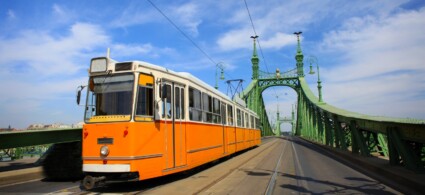

Budapest is a fortunate case of a city where human intervention has been able to enhance the scenic beauty of the area with elegant buildings of regal charm.
Budapest’s charm is evident from the very first steps into the city center, but which is best appreciated from one of the city’s vantage points. It is even better if you observe Budapest from above at sunset, when its magnificent Baroque, neoclassical, and art nouveau buildings are expertly illuminated and give the city an even more magical atmosphere.
But the Pearl of the Danube is not only a top destination for architecture enthusiasts or couples looking for romantic glimpses. It is both a modern metropolis perfect for young people looking for wild nightlife and a relaxation capital with a high concentration of thermal baths are an ancient tradition.
Your choice, a vacation in Budapest can be rejuvenating or electrifying. Ready to hit the road?

The city of Budapest is located in the north-central part of Hungary. Historically, it was born from the union of two cities, Pest and Buda, divided by the Danube River: the Pest part overlooks the Hungarian plain, while the Buda area is mostly hilly.
Looking at a map of Hungary, the border with Slovakia will seem very close to Budapest: in fact it is only about a hundred kilometers away.
Budapest’s climate is typically continental, with cold winters and warm summers. In winter snowfall is quite common, while in summer there is little rain.
When to go to Budapest depends a lot on the type of vacation you want to take. If you are aiming for a cultural vacation, the best time is spring, during which numerous festivals are held, the best known and most prestigious of which is the Spring Festival.
Summer is the best time to visit Budapest if you love nightlife because the banks of the Danube come alive with outdoor clubs with music until late at night and in general there is a festive and lively atmosphere.
Winter is more suitable if you want a spa weekend or a romantic vacation. The atmosphere of the Christmas season, with its traditional markets, is truly magical — higher prices, but worth it.
To know what to pack always take a look at the weather forecast before you leave.

Budapest has a wealth of museums and monuments, and if you then add the attractions in the surrounding area, the list of what to visit can become very long indeed.
For those who are short on time or for those who want to aim for the best right away, here are the 5 things you absolutely must see in Budapest.
Budapest’s most famous image is that of the magnificent Buda Castle, an imposing complex of buildings that stands proudly atop Várhegy, Budapest’s hill, and for 300 meters overlooks the Danube.
It is also known as the Royal Palace because it was once home to Hungarian royalty; today, however, it is home to prestigious cultural institutions: the Széchenyi Library, the Hungarian National Gallery, and the Budapest Museum of History.
By day it appears at times elegant and at times austere, but when the sun goes down and its walls are illuminated, the castle becomes surprisingly atmospheric-a truly exciting sight!
You can reach it on foot or more comfortably by funicular railway, and once at the top you can enjoy splendid panoramic views of the city.
Also connected to Buda Castle is the city’s second iconic image, the iconic Chain Bridge that spans the Danube joining the heart of Pest to the steps leading up to Buda Castle.
The first permanent bridge across the Danube to be opened in Hungary, it is now the most photographed of Budapest’s bridges and is especially romantic at night.
At first glance it will remind you somewhat of London’s Tower Bridge, and indeed the engineer who designed it is of British origin, but the effect is short-lived: Budapest’s Chain Bridge, with its neoclassical pillars and the four lions at their base, exerts its own unique and inimitable magic.
Spectacular: any other adjective used to describe the Budapest Parliament seen as a whole from the outside would be reductive.
This magnificent building, which stretches more than 250 meters along the east bank of the Danube, was built to celebrate the independence from the Austro-Hungarian Empire achieved in the mid-19th century and is still a strong symbol of national identity and pride.
And how can we not be proud of it? This opulent palace is a true architectural gem: admire it from the outside, after which join one of the guided tours to enter its richly decorated halls.
In Budapest, relaxation is one of the top attractions! Of all the thermal baths in the city, the most impressive is the famous Szechenyi Thermal Baths, housed inside an elegant historic building surrounded by greenery in Városliget Park.
Built at the end of the 19th century, the Szechenyi Baths retain their fin de siècle charm intact: you can immerse yourself in pools of hot water with many beneficial properties while admiring the beauty of the surrounding architecture… even in the middle of winter!
A must-see attraction is Matthias Church, which stands on the castle hill. It is a magnificent late Gothic-style church, recognizable by its colorful roof decorated with Zsolnay ceramic tiles forming geometric patterns.
Witnessing more than 700 years of history, during which it was the site of royal coronations and weddings, the church reached its peak from the 19th century onward and is still the custodian of valuable artistic treasures.
The easiest and cheapest way to get to Budapest is certainly to take a plane, and the supply of low-cost flights is very good.
A more fascinating journey, which allows you to admire the different landscapes that follow one another, is to get to Budapest by train.


The first question to ask when looking for a hotel in Budapest is: is it better to stay in Buda or Pest? The answer in almost all cases is: better Pest.
The lower city on the right bank of the Danube is full of interesting monuments and attractions, plus it is a lively shopping area with many restaurants and clubs to spend the evening.
Buda, the upper city on the left bank of the river, is fascinating to visit during the day but very quiet – for some even too quiet- during the evening.
Recommended areas to look for a hotel or vacation apartment in Budapest are around Vorosmarty Ter and Vaci Utca, the neighborhood of St. Stephen’s Basilica, Rady Utca, Belvaros and Oktogon.



Budapest is a rather large city and getting around the center on foot is somewhat difficult, but on the other hand it is easy to get around by public transport. Budapest’s public transportation network includes the metro (4 lines), buses (more than 200 lines including night buses), and streetcars (40 lines).
The most convenient means of transportation is the metro, which provides quick access to all areas of tourist interest. A curiosity: the Budapest metro is the second oldest in Europe, after London’s.
Don’t miss a ride on streetcar line 2, with a route largely parallel to the Danube that allows you to see some of the city’s most interesting sights from an unusual perspective.
Another option for getting around, recommended for those who like convenience, is to use the hop on hop off tourist buses: these are buses from private companies that run routes designed especially for tourists, with stops at the most beautiful museums, monuments and things to see in Budapest.



City Card allow you to save on public transport and / or on the entrances to the main tourist attractions.
